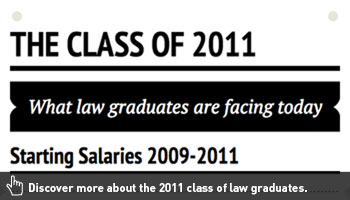Making a law degree work is getting harder and harder. As law school debt continues to rise, graduates face stagnant – and in some cases declining – starting wages as big law firms cut back on new graduate hiring.
The average starting salary for law school graduates declined from $72,000 in 2009 to $60,000 for 2011, according to a National Association for Law Placement study. Historically, there have been two primary salary clusters, one at $160,000 for big law firms and another between $40,000 and $60,000 for other law jobs, including government, public interest and smaller firm jobs. The big law firms, those with over 500 employees, propped up starting mean salaries over the years, but since the recession, these jobs have disappeared while overall wages remained stagnant. The result was a declining average wage for new graduates.
“What happened in the aftermath of the recession, a lot of the jobs at the big law firms just went away. They don’t exist anymore,” said James Leiphold, executive director for the NALP.
Michael, a 2008 graduate of Fordham law, was part of the last graduating class to take advantage of the big law firm job offers. His was also the first graduating class to bear the brunt of the downsizings. Michael declined to use his last name as not to identify his current employer.
“As soon as the recession hit that year, there were massive, massive layoffs. A significant chunk of lawyers lost their jobs, that was the end of the big firms,” he said.
Michael had taken a position at a smaller firm focusing on labor and employment law. When the recession hit, he watched as fellow classmates lost their jobs at the big firms, but, gratefully, he was able to keep his position by taking a $10,000 salary cut. The psychological and professional impact pushed some of his classmates out of the law industry all together, he said.
“The experience of my class was probably as good as it gets in initial hiring and as devastating as it gets with layoffs,” said Michael.
 Leiphold expected that the biggest law firms would continue to hold back and hire only small groups of new lawyers. He believed more jobs would open up in small firms and public interest law, which have faced even worse wage stagnation. Public interest salaries have been stagnant for 10 years or more, said Leiphold.
Leiphold expected that the biggest law firms would continue to hold back and hire only small groups of new lawyers. He believed more jobs would open up in small firms and public interest law, which have faced even worse wage stagnation. Public interest salaries have been stagnant for 10 years or more, said Leiphold.
Job prospects have only worsened for following graduating classes. More students are graduating from law school each year than there are jobs available, according to the Bureau of Labor Statistics occupational outlook for lawyers.
The biggest law firms have continued to hold back and have hired only small groups of new lawyers, Leiphold said. He believed more jobs would open up in small firms and public interest law, but public interest salaries have seen even worse wage stagnation over the past 10 years.
Combine declining job prospects and stagnant wages with the ever rising cost of a law degree and the result is a plummeting standard of living for new graduates year over year. The average debt load for a student coming out of one of the top ten schools ranked by U.S. News & World Report was $124,800 for the 2012 class of graduates, the highest yet.
Finding a way for these graduates to find jobs and pay off their debt is becoming a primary concern not only for law students but for the schools, as well.
“What we’re going through right now is a big economic correction,” said Leiphold. “Legal demands will only continue to rise. The market will figure out how to educate them for less or pay them more or a combination of both.”
Georgia State University, historically one of the more affordable law programs according to U.S. News & World Report, has seen decreased hiring from the large and medium firms, in line with the national trend.
“We’ve seen stagnant wages across the board,” said Vickie Brown, director of GSU law school’s career services office. “Many large-medium firms actually scaled back wages about three years ago to survive through the downturned economy, those higher salary levels have not returned.”
Brown said many of the larger firms shifted to hiring experienced attorneys and less new graduates. In response, GSU started a new program called SHARP to market law students and new graduates as temporary workers to meet urgent needs, often leading to full-time opportunities for graduates.
Other law schools encouraged graduates to take alternative routes to the large law firms. Michael Ricciardelli, the legal media officer for Seton Hall University, said that a third of their students took judicial clerkships for one to two years after graduation. After clerkships, nearly 94 percent of those students went to work with a large law firm.
“Many people think of it as a finishing school,” said Ricciardelli of the judicial clerkships.
Recently, the new crop of 2013 summer associates signed on at the big law firms, the first step toward the coveted $160,000 starting salary. Belinda Liu, a second year law student at Cornell University, secured her position in New York City this summer.
“It’s getting better. The market is recovering, but it’s still not back where it was,” said Liu.




